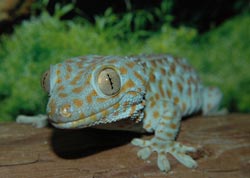UA scientists collaborate to gain understanding of self-cleaning gecko foot hair

A gecko-inspired adhesive can function under conditions where traditional adhesives do not, possibly inspiring new applications.<br>
Wall-climbing robots, bioadhesives or other sticky substances can benefit greatly from a recent discovery about the self-cleaning and reuse abilities of a gecko’s foot hair by a University of Akron graduate student-researcher and his partners. Their work was published in the June 13 edition of Interface, the Journal of the Royal Society.
The sticky yet clean attribute of this discovery is the gecko toe pad and its ability to repeatedly attach and detach to a surface.
Researchers Shihao Hu, a UA mechanical engineering student, and biologist and recent UA graduate Stephanie Lopez-Chueng of Keiser University in Fort Lauderdale, Fla., and their team discovered that the clue to a dynamic self-cleaning mechanism in gecko setae, or microscopic foot hair, is achieved through the hyperextension of their toes.
“The analysis reveals that geckos have tiny sticky hairs on their toes called setaes, and due to the attaching and detaching mechanism caused by the rolling and peeling motion of their toes as they walk, they release the dirt particles leaving their feet clean,” Hu says. “The dynamic hyperextension effect of its natural toe peeling increases the speed of the cleaning to nearly twice as fast as previously perceived.”
Partners in the study included Hu; Lopez-Chueng; Dr. Peter Niewiarowski, interim director, UA Integrated Bioscience Ph.D. program; and Zhenhai Xia, University of North Texas, Materials Science and Engineering.
The findings, published in the article, “Dynamic Self-Cleaning in Gecko Setae via Digital Hyperextension,” show that a gecko-inspired adhesive can function under conditions where traditional adhesives do not, possibly inspiring new applications in space or water exploration tools or in common items like duct tape or other products that use sticky properties.
“Through biomimicry, a gecko-inspired adhesive can function under conditions where traditional adhesives do not, such as in a vacuum, outer space or under water,” Niewiarowski says. “More broadly, a gecko-inspired adhesive would be able to bind materials together very strongly yet also release very easily. Imagine a tape that binds things together securely like duct tape yet can also be removed and reused over and over again like a post-it note.”
About The University of Akron
The University of Akron is the public research university for Northeast Ohio. The Princeton Review listed UA among the “Best in the Midwest” in its 2011 edition of Best Colleges: Region-by-Region. Nearly 30,000 students are enrolled in UA’s 300 associate, bachelor’s, master’s, doctoral and law degree programs and 100 certificate programs at sites in Summit, Wayne, Medina and Holmes counties. For more information, visit The University of Akron.
Media contact: Denise Henry, 330-972-6477 or henryd@uakron.edu
Media Contact
More Information:
http://www.uakron.eduAll latest news from the category: Life Sciences and Chemistry
Articles and reports from the Life Sciences and chemistry area deal with applied and basic research into modern biology, chemistry and human medicine.
Valuable information can be found on a range of life sciences fields including bacteriology, biochemistry, bionics, bioinformatics, biophysics, biotechnology, genetics, geobotany, human biology, marine biology, microbiology, molecular biology, cellular biology, zoology, bioinorganic chemistry, microchemistry and environmental chemistry.
Newest articles

Sea slugs inspire highly stretchable biomedical sensor
USC Viterbi School of Engineering researcher Hangbo Zhao presents findings on highly stretchable and customizable microneedles for application in fields including neuroscience, tissue engineering, and wearable bioelectronics. The revolution in…

Twisting and binding matter waves with photons in a cavity
Precisely measuring the energy states of individual atoms has been a historical challenge for physicists due to atomic recoil. When an atom interacts with a photon, the atom “recoils” in…

Nanotubes, nanoparticles, and antibodies detect tiny amounts of fentanyl
New sensor is six orders of magnitude more sensitive than the next best thing. A research team at Pitt led by Alexander Star, a chemistry professor in the Kenneth P. Dietrich…





















